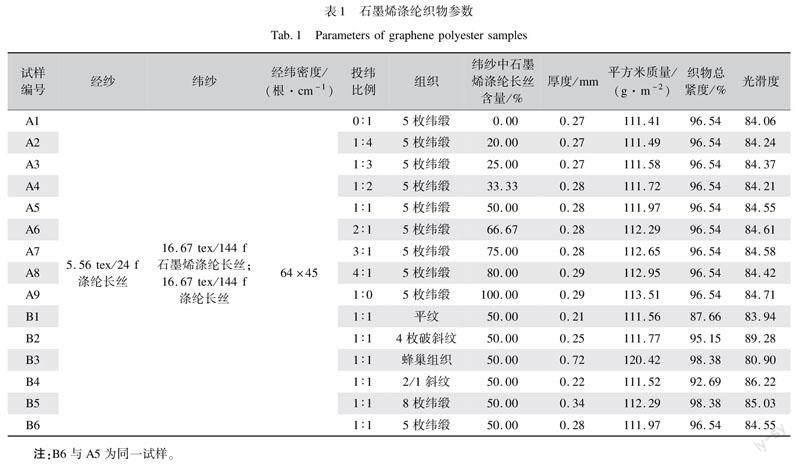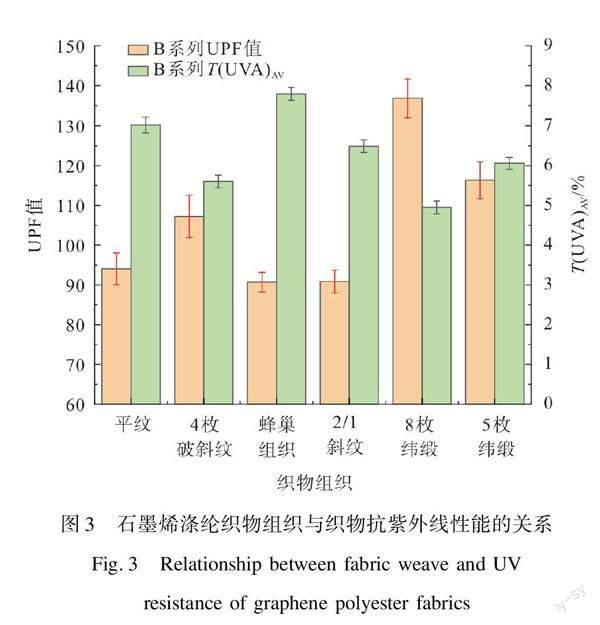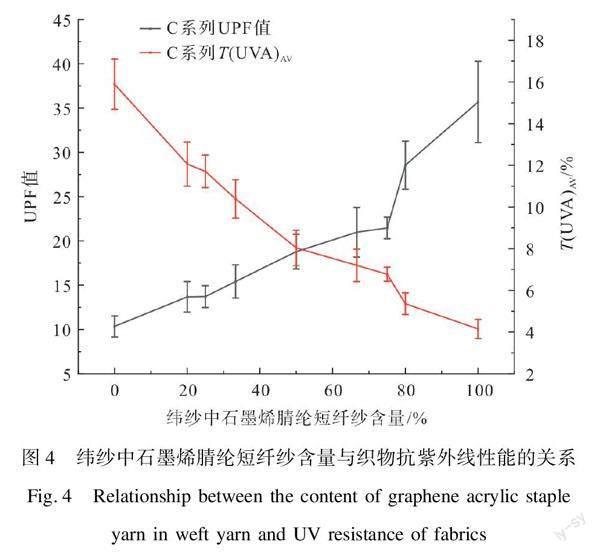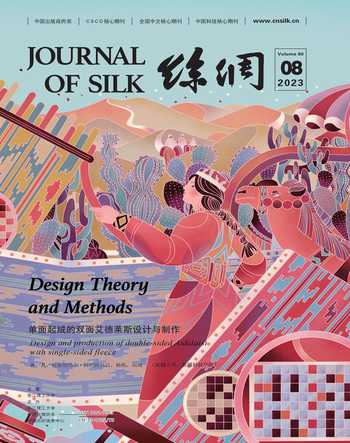抗紫外与远红外石墨烯机织物的性能研究
史洋涛 吕思晨 张金珍 范硕 祝成炎 张红霞












摘要: 为了探讨纬纱中石墨烯功能性纱线种类、含量及不同织物组织对石墨烯机织物的抗紫外线性能和远红外性能的影响,文章分别以石墨烯涤纶长丝、石墨烯腈纶短纤纱、普通涤纶长丝和黏胶短纤纱为原料,设计织造了4个系列具有不同织物规格的28种织物试样。对所得28种织物试样分别进行抗紫外线性能和远红外性能测试,并通过模糊综合评判方法对试样相关指标进行评判。结果表明:随着纬纱中石墨烯功能性纱线含量的增加,织物的抗紫外线性能和远红外性能逐渐增强;织物组织越紧密,平均浮长越长,表面越光滑,织物的抗紫外线性能越强;织物表面越粗糙,厚度越厚,织物的远红外性能越好;当纬纱中石墨烯功能性纱线含量达到100%时,组织采用8枚纬缎或5枚纬缎的试样抗紫外线和远红外综合性能达到最优。
关键词: 石墨烯机织物;抗紫外线;远红外;功能性纱线;织物组织;模糊综合评判
中图分类号: TS101.923 文献标志码: A
文章编号: 10017003(2023)080054-09
引用页码: 081107 DOI: 10.3969/j.issn.1001-7003.2023.08.007
随着人们生活水平的日渐提高,对纺织品的需求不再局限于保暖,而是转向具有生态環保、时尚美观、舒适智能的抗紫外和远红外功能性高附加值纺织产品[1-2]。对于长期在户外工作的人们,紫外线的辐射会对人体健康产生不可小觑的影响。紫外线会影响真皮组织中的胶原纤维和弹力纤维,极易造成皮肤损伤、老化,产生黑色素和色斑,甚至还会引发癌症。对于远红外功能性纺织品而言,当户外气温降低时,它能够在远红外线的辐射下,促进人体血液循环、改善循环系统、增强新陈代谢、提高免疫功能。因此,研究和开发抗紫外线和远红外复合功能织物具有重要意义。
为了实现纺织品功能的多样化,功能性整理技术成为开发功能性纺织品的有效方法之一[3]。近年来,石墨烯作为一种新型功能性材料,在保暖、抗菌、抗静电、抗紫外线、远红外辐射温升等方面具有优异的性能,不仅广泛用于电池、传感器、半导体材料、储能和新型显示等领域,而且在纺织产业中也拥有良好的发展前景[4]。研究表明:石墨烯有着较强的抗紫外线性能,可以吸收低于281 nm波长的紫外线,也能反射高于281 nm波长的紫外线[5-6],且石墨烯具有良好的远红外性能,在低温情况下,石墨烯织物可通过吸收外界或人体辐射的远红外线,使自身温度升高,解决局部皮肤冰凉的问题。其还能够发射与人体相匹配的远红外线,渗入体内细胞,加快人体的新陈代谢,达到保暖和保健的目的[7]。
因此,本文选用石墨烯功能性纱线和普通涤纶长丝、黏胶短纤纱进行交织,试织了18种石墨烯功能性纱线含量不同的试样和10种织物组织不同的试样。通过改变织物中石墨烯功能性纱线含量、织物组织和原料,来研究其对石墨烯机织物的抗紫外线性能和远红外性能的影响。最后,通过模糊综合评判的方法,开发出综合性能最优的抗紫外线和远红外线复合功能石墨烯机织物。
1 实 验
1.1 原 料
所使用的经纱为5.56 tex/24 f的涤纶长丝(中纺面料科技有限公司)。纬纱为16.67 tex/144 f的石墨烯涤纶长丝,石墨烯含量为1%的000000630000005360型纱线(济南圣泉集团股份有限公司);20 tex的石墨烯腈纶短纤纱,石墨烯含量为1%的000000630000003721型纱线(济南圣泉集团股份有限公司);20 tex的黏胶短纤纱(中纺面料科技有限公司)。
1.2 功能织物制备方法
所有试样采用相同工艺进行织造,通过调整经纬纱种类、经纬密度、投纬比例及组织,最终织造得到28种试样。其中9种是在组织均为5枚纬缎的情况下按照石墨烯涤纶长丝在纬纱中的含量从0~100%进行试织的,5种是在石墨烯涤纶长丝与普通涤纶长丝的投纬比例为1︰1时采用5种不同组织进行织造,9种是在组织均为5枚纬缎的情况下按照石墨烯腈纶短纤纱在纬纱中的含量从0~100%进行试织的,5种是在石墨烯腈纶短纤纱与黏胶短纤纱的投纬比例为1︰1时采用5种不同组织进行织造。具体规格参数如表1、表2所示,各织物的组织图如图1所示。
1.3 测 试
1.3.1 织物的抗紫外线性能测试
原理:用UV射线辐射试样,收集总的光谱透射射线,测定出总的光谱透射比,并计算试样的紫外线防护系数UPF值和紫外线辐射平均值T(UVA)AV。
仪器:UV-2000S紫外线透过率分析仪(Labsphere公司)。
步骤:1) 根据GB/T 18830—2009《纺织品防紫外线性能的测定》,将每种试样放置在温度为(20±2) ℃、相对湿度为(65±4)%的标准大气环境下调湿平衡24 h。2) 开启分析仪,进行预热30 min,预热完毕后将试样平整地铺在测试点处,点击测试按钮进行测试。在每种试样的5个不同位置测试,记录UPF值和T(UVA)AV的平均值。计算如下式所示:
2 结果与分析
本文主要研究石墨烯涤纶试样和石墨烯腈纶试样的抗紫外线性能和远红外性能,所以分别对涤纶试样和腈纶试样进行测试分析。
2.1 抗紫外线性能研究
通常紫外线照射在织物上时,会被织物表面反射一部分、吸收一部分,其余的紫外线从织物的缝隙中透过,照射到人体表面,对皮肤造成伤害。总而言之,织物表面吸收和反射的紫外线越多,透过织物的紫外线越少,织物的抗紫外线性能越强。因此,抗紫外线织物要增强织物对紫外线的吸收和反射能力,就需要减少紫外线的透过率[8]。石墨烯涤纶试样的抗紫外线性能如图2、图3所示。石墨烯腈纶试样的抗紫外线性能如图4、图5所示。
由图2可知,A系列试样的抗紫外线性能随着纬纱中石墨烯涤纶长丝含量的增加而增强。根据GB/T 18830—2009规定,防紫外线产品需要满足UPF值大于40,且T(UVA)AV小于5%。当纬纱中石墨烯涤纶长丝含量不低于66.67%时,试样达到“防紫外线产品”标准,即A6、A7、A8、A9试样可称之为“防紫外线产品”。当纬纱中石墨烯涤纶长丝含量达到100%时,试样的抗紫外线性能最好,UPF值达到了1 433.56,T(UVA)AV为0.32%,这是因为石墨烯涤纶长丝有着优异的抗紫外线功能,增强了试样的抗紫外线性能。此外,纤维的微观结构对试样的抗紫外线性能也有较大影响,石墨烯涤纶纤维为1.16 dtex,比普通涤纶纤维2.32 dtex更细,比表面积更大,试样的抗紫外线性能越好[9]。
由图3可知,B系列试样的抗紫外线性能与织物组织有关。除B5试样是“防紫外线产品”,其余试样均不满足国家标准。根据国标要求,试样的UPF值越大,T(UVA)AV越小,试样抗紫外线性能越好,抗紫外线性能最好的是8枚纬缎,其次是5枚纬缎,最差的是蜂巢组织。这是由于织物组织不同,织物的紧度、厚度、平方米质量和平均浮长不同,8枚纬缎试样的浮长最长,紧度也最大,厚度较大,平方米质量也较大,故试样的抗紫外线能力最强。蜂巢组织试样的紧度、厚度和平方米质量也较强,但蜂巢组织试样抗紫外线能力最弱的原因是织物组织不同,经纬纱交织状况不同,其空间几何形态也不同,蜂巢组织试样经纬纱交织次数较多,其经纬纱屈曲相对较多,试样表面光滑度最低,为80.90,对紫外线的反射能力最差,因此蜂巢组织试样的抗紫外线性能最差[10]。
由图4可知,C系列试样的抗紫外线性能随着纬纱中石墨烯腈纶短纤纱含量的增大而缓慢增强。但9块试样UPF值均未大于40,且只有C9试样长波紫外线T(UVA)AV小于5%,故C系列均不属于“防紫外线产品”。这是因为织物的经纬密度也是影响织物抗紫外线能力的重要因素[11]。C系列试样的纬密比较小,覆盖度较小,紫外线透过率较高,试样的抗紫外线性能较差[12]。
由图5可知,D系列试样均不属于“防紫外线产品”。随着织物组织的变化,不同组织试样的抗紫外线性能差异不大。8枚纬缎试样的抗紫外线性能最好,UPF值为19.40,T(UVA)AV为7.73%。蜂巢组织试样的抗紫外线性能最差,UPF值为17.02,T(UVA)AV为9.53%。这是因为织物的抗紫外线性能受织物组织的变化影响较小,受织物密度的影响更大[13],D系列试样纬密较小,紫外线透过率较高,试样的抗紫外线性能都较差。
综上所述,随着纬纱中石墨烯功能性纱线含量的增大,试样的抗紫外性能也逐渐增强,织物组织对织物的抗紫外线性能有较大影响,采用浮长线较长且浮长线排列规律不明显的组织,可以获得良好的抗紫外线效果。同时,随着组织结构改变引起的织物厚度、平方米质量和紧度变化也是影响织物抗紫外线性能的重要因素。织物的厚度越大,透过织物的紫外线越少,平方米质量越大,紧度越紧,从空隙中透过的紫外线越少,织物表面越光滑,对紫外线的反射越多,织物的抗紫外线性能越好。当织物的纬密增大时,覆盖度增大,织物抗紫外线性能增强,故石墨烯涤纶试样的抗紫外线性能相比石墨烯腈纶试样较好。这是由于织物原料对织物抗紫外线性能有重要影响,涤纶分子结构中的苯环对紫外线具有很强的吸收能力,致使其具有较好的抗紫外线能力[14]。此外,与石墨烯腈纶试样相比,石墨烯涤纶试样的纬密较大,纬纱所用的纤维较细,表面积较大,紫外线透射率较低,使得石墨烯涤纶试样的抗紫外线性能更好。
2.2 织物远红外线性能研究
远红外线是指波长在2.5~1 000.0 μm的电磁波,它可以为人体细胞的运作提供微弱能量,促进人体微循环[15]。远红外纺织品不仅能够吸收物质辐射的能量,而且能够以红外辐射的形式作用于人体,当人体吸收大量相匹配的远红外线时,细胞和血液中的C—C、C—O、C—H和C—N等化学键会产生共振效应,导致皮肤温度升高,通过人体反射弧产生扩张毛细血管的物质,增强人体血液循环;同时共振效应使得机体分子处于高振动水平,核酸蛋白质等的活性会被激发,可以调节人体代谢和增强免疫等功能,起到防治疾病的辅助作用[16-18]。石墨烯涤纶试样的远红外性能如图6、图7所示。石墨烯腈纶试样的远红外性能如图8、图9所示。
由图6可知,随着纬纱中石墨烯涤纶长丝含量的增加,A系列试样的远红外线性能逐渐增强。这是因为石墨烯纤维具有较强的远红外辐射能力,可以在常温下吸收物质辐射的能量,以远红外的形式作用于人体[19]。当纬纱中石墨烯涤纶长丝含量增加时,吸收周围物质的能量增多,发射出的远红外线增多,试样的远红外性能也增强。根据GB/T 30127—2013标准规定,具有远红外性能试样的远红外发射率应不低于0.88%,远红外辐射温升不低于1.40 ℃。当试样纬纱中石墨烯涤纶长丝含量不低于25.00%时,试样远红外发射率大于0.88%,远红外辐射温升大于1.40 ℃,试样达到远红外织物的标准。当试样纬纱中石墨烯涤纶长丝含量为50%时,试样的远红外发射率和远红外辐射温升增长速度逐渐变缓。当纬纱中石墨烯涤纶长丝含量达到100%时,试样远红外性能最好,远红外发射率达到了0.932%,远红外辐照温升为1.97 ℃,这是因为温度高于绝对零度的物体会辐射红外线。红外线是一种电磁波,织物中的电子吸收外界能量激发,外层的电子会脱离原来的轨道,进入到更高的能位上。然而,电子在更高的能位上不够稳定,会通过释放能量回到原来的能位。随着试样中石墨烯涤纶长丝含量的增加,试样中石墨烯也在增加,人体和外界辐射的能量吸收得越多,作用于人体的远红外线也越多,故试样的远红外性能越好。
由图7、图9可知,B、D系列试样均符合远红外织物的标准,但織物组织对远红外性能有一定影响。蜂巢组织试样的远红外性能最好,8枚纬缎试样的远红外性能最差。织物的远红外发射率与织物表面的形态有关,织物表面越粗糙,远红外发射率也就越大。在B、D系列试样中,蜂巢组织试样的表面最粗糙,厚度也最厚的,故其远红外性能最好[20]。8枚纬缎试样的远红外性能相比平纹斜纹的差,这是因为随着织物枚数的增加,织物表面会更光滑,当远红外线辐射到物体表面时,对远红外光线的反射能力也越强,织物的远红外性能越差。此外,8枚纬缎织物相比其他组织织物,其反射红外线更多,吸收更少[21]。
由图8可知,C系列试样的远红外性能随着纬纱中石墨烯腈纶短纤纱含量的增大而增强。当纬纱中石墨烯腈纶短纤纱含量不低于20%时,C2~C9系列试样均符合远红外织物的标准,且织物的远红外发射率与远红外辐射温升的变化规律与石墨烯涤纶织物性能基本一致。
结合上述分析得出,增加纬纱中石墨烯涤纶长丝或石墨烯腈纶短纤纱含量可以增强织物远红外性能。此外,织物组织对织物远红外性能也有一定的影响,织物组织影响了织物表面形态,织物越粗糙,厚度越厚,远红外性能越好。
3 模糊综合分析
结合上述结果分析可得出,在A、C系列试样中,纬纱中石墨烯涤纶长丝或石墨烯腈纶短纤纱含量为100%时,试样的抗紫外和远红外综合性能为最好,即A9、C9综合性能最好。而对于B、D系列试样而言,不能直接通过数据得出不同织物组织的综合性能优劣。为了能定量且系统性地分析出具有最佳抗紫外线和远红外复合功能的试样,本文进一步采用模糊数学综合评判的方法对B、D系列试样的抗紫外线、远红外性能分别进行综合评判,从中选择出综合性能最佳的试样。
3.3 确定权重集A
权重集反映评价因素的重要性,权重系数越大,表明该因素在综合评判中越重要。本文根据对织物性能模糊综合评判的相关参考文献[10,23],以及通过问卷调查的方式,让20位纺织、服装相关专业的学生和老师根据户外工作者对服装的抗紫外线和远红外功能需求,为这四个指标进行百分制打分,然后根据结果计算出各项指标的平均分,得出权重系数,如表3所示。最终得到的权重集为A={0.42,0.18,0.24,0.16},即UPF值的权重系数为0.42,T(UVA)AV的权重系数为0.18,远红外发射率的权重系数为0.24,远红外辐射温升的权重系数为0.16。
3.4 计算综合评判矩阵B
已知权重集A和单因素矩阵R,计算综合评判矩阵如下式所示:
B=A·R(6)
评判值越大,综合性能越优。经计算得到:
B系列综合评判矩阵
B=(0.376,0.528,0.400,0.416,0.600,0.531)
D系列综合评判矩阵
B=(0.453,0.516,0.400,0.339,0.600,0.698)
由模糊综合评价结果可知,B系列试样综合性能排序为B5>B6>B2>B4>B3>B1。即B系列试样中8枚纬缎织物综合性能最好,5枚纬缎织物次之,平纹织物最差。D系列试样综合性能排序为D6>D5>D2>D1>D3>D4。即D系列试样中5枚纬缎织物综合性能最好,8枚纬缎织物次之,2/1斜纹织物最差。
4 结 论
本文以普通涤纶长丝、石墨烯涤纶长丝、石墨烯腈纶短纤纱和黏胶短纤纱为原料,试织了多种比例和组织结构的试样,并测试了试样的抗紫外线性能和远红外性能。通过模糊综合评判分析出试样最佳方案,得出如下结论:
1) 织物的抗紫外线性能随着纬纱中石墨烯涤纶长丝或石墨烯腈纶短纤纱含量的增加而增强,当纬纱中石墨烯涤纶长丝含量为100%時,石墨烯涤纶试样的抗紫外性能最好,UPF值达到了1 433.56,T(UVA)AV为0.32%;织物组织和纬密对织物的抗紫外线性能有较大影响,8枚纬缎石墨烯涤纶试样的抗紫外线性能最好,UPF值为136.84,T(UVA)AV为4.95%,是由于纬密较大,平均浮长最长,经纬纱交织点较少,透射过试样的紫外线较少,故试样的抗紫外线性能最好;石墨烯腈纶蜂巢组织试样的抗紫外线性能最差,UPF值为17.02,T(UVA)AV为9.53%,是由于其纬密较小,覆盖度较小,表面光滑度最低,对紫外线的反射能力最差,故试样的抗紫外线性能最差。
2) 织物的远红外性能也随着纬纱中石墨烯涤纶长丝或石墨烯腈纶短纤纱含量的增大而增强,当纬纱中石墨烯腈纶短纤纱含量为100%时,石墨烯腈纶试样的远红外性能最好,远红外发射率为0.949%,远红外温升为2.13 ℃;织物的远红外性能还与织物表面形态有关,石墨烯腈纶试样的远红外性能最好,远红外发射率为0.954%,远红外温升为2.03 ℃,是由于试样的厚度较厚,表面最粗糙,对红外光线的反射能力较弱,故试样的远红外性能越好。
3) 通过模糊综合评判的方法得出,在B系列中,8枚纬缎试样是抗紫外线和远红外综合性能最优的试样;在D系列中,5枚纬缎织物是综合性能最优的试样。本文研究的试样通过调节不同投纬比和组织,挑选出具有抗紫外线和远红外线复合功能最佳的试样,可为后续开发石墨烯功能化纺织品提供参考。
参考文献:
[1]徐建云, 黄启英, 娄亿, 等. 浅谈国内纺织品检验检测行业发展的机遇与挑战[J]. 中国纤检, 2022(8): 96-101.
XU Jianyun, HUANG Qiying, LOU Yi, et al. Brief discussion on the opportunities and challenges of the development of domestic textile inspection and testing industry[J]. China Fiber Inspection, 2022(8): 96-101.
[2]高小红, 臧子雪, 周允涵. 功能性纺织产品的创新开发与趋势[J]. 纺织导报, 2021(1): 85-89.
GAO Xiaohong, ZANG Zixue, ZHOU Yunhan. Innovative development and trend of functional textiles[J]. China Textile Leader, 2021(1): 85-89.
[3]崔书健. 功能性纺织品趋向多元化[J]. 纺织科学研究, 2019(5): 63.
CUI Shujian. Functional textiles tend to diversify[J]. Textile Science Research, 2019(5): 63.
[4]孙楠. 石墨烯及其功能纺织品的研究进展[J]. 天津纺织科技, 2019(3): 60-64.
SUN Nan. Research progress of graphene and its functional textiles[J]. Tianjin Textile Science & Technology, 2019(3): 60-64.
[5]苗广远, 张占柱. 纯棉织物的氧化石墨烯防紫外线整理[J]. 印染, 2017, 43(2): 35-37.
MIAO Guangyuan, ZHANG Zhanzhu. Anti-UV finish of cotton fabrics with graphene oxide[J]. China Dyeing & Finishing, 2017, 43(2): 35-37.
[6]QU L, TIAN M, HU X, et al. Functionalization of cotton fabric at low grapheme nanoplate content for ultrastrong ultraviolet blocking[J]. Carbon, 2014, 80: 565-574.
[7]叶鑫, 王敏, 李俊. 石墨烯功能纺织品的制备与性能研究进展[J]. 产业用纺织品, 2021, 39(10): 1-7.
YE Xin, WANG Min, LI Jun. Research progress in preparation and properties of graphene functional textiles[J]. Technical Textiles, 2021, 39(10): 1-7.
[8]曹桂红, 彭新元. 织物防紫外线性能研究[J]. 湖南工程学院学报(自然科学版), 2018, 28(1): 80-84.
CAO Guihong, PENG Xinyuan. Compared with anti ultraviolet fabric performance test[J]. Journal of Hunan Institute of Engineering (Natural Science Edition), 2018, 28(1): 80-84.
[9]刘杰, 周蓉, 卢士艳. 影响抗紫外线纺织品防护性能因素的研究[J]. 中原工学院学报, 2004(3): 32-34.
LIU Jie, ZHOU Rong, LU Shiyan. Study on factors influencing ultraviolet protective properties of fabrics[J]. Journal of Zhongyuan University of Technology, 2004(3): 32-34.
[10]周驚鸿, 张红霞, 祝成炎, 等. 大豆蛋白纤维交织物的保健性能研究[J]. 丝绸, 2022, 59(3): 33-39.
ZHOU Jinghong, ZHANG Hongxia, ZHU Chengyan, et al. Research on the health care property of soybean fiber intertexture[J]. Journal of Silk, 2022, 59(3): 33-39.
[11]潘薇, 王韵杰, 祝成炎, 等. 抗紫外吸湿排汗复合功能织物的性能研究[J]. 丝绸, 2021, 58(3): 30-35.
PAN Wei, WANG Yunjie, ZHU Chengyan, et al. Study on the properties of fabric with UV-resistant, moisture absorbance and wicking functions[J]. Journal of Silk, 2021, 58(3): 30-35.
[12]吴国风. 纺织品的抗紫外线整理方法及评价[J]. 纺织科技进展, 2010(5): 20-23.
WU Guofeng. The method and evaluation of UV finishing on textiles[J]. Progress in Textile Science & Technology, 2010(5): 20-23.
[13]杨璧玲, 罗旭平. 纺织品抗紫外线性能影响因素及其测试[J]. 纺织导报, 2014(4): 88-90.
YANG Biling, LUO Xuping. Factors affecting anti-ultraviolet performance of textiles and related tests[J]. China Textile Leader, 2014(4): 88-90.
[14]屠慕欣, 马越, 孙悦, 等. 漫谈防紫外线纺织品[J]. 辽宁丝绸, 2020(2): 58-59.
TU Muxin, MA Yue, SUN Yue, et al. Talk about UV protection textiles[J]. Liaoning Tussah Silk, 2020(2): 58-59.
[15]杜敏芝, 田明伟, 曲丽君. 远红外纺织品及新型石墨烯远红外功能纺织品的研究进展[J]. 成都纺织高等专科学校学报, 2016, 33(4): 132-137.
DU Minzhi, TIAN Mingwei, QU Lijun. Research progress of far-infrared textiles and new graphene far-infrared functional textiles[J]. Journal of Chengdu Textile College, 2016, 33(4): 132-137.
[16]高冰, 许亚娟, 管新海, 等. 远红外保暖涤纶织物性能研究[J]. 上海纺织科技, 2016, 44(2): 24-28.
GAO Bing, XU Yajuan, GUAN Xinhai, et al. Research on the performance of far-infrared thermal fabric[J]. Shanghai Textile Science & Technology, 2016, 44(2): 24-28.
[17]鹿娜, 李俊伟, 吕丽华, 等. 纳米石墨烯/PLA远红外纤维制备及性能研究[J]. 印染助剂, 2018, 35(11): 33-36.
LU Na, LI Junwei, L Lihua, et al. Preparation and properties of nano-graphene/PLA far infrared fibers[J]. Textile Auxiliaries, 2018, 35(11): 33-36.
[18]沈国先, 赵连英. 远红外材料及纺织品保健功能的试验研究[J]. 现代纺织技术, 2012, 20(6): 53-57.
SHEN Guoxian, ZHAO Lianying. Experimental study on far infrared material and textiles health function[J]. Advanced Textile Technology, 2012, 20(6): 53-57.
[19]霍子龙, 许多, 吴圆凤, 等. 远红外功能纤维的研究现状及展望[J]. 染整技术, 2021, 43(7): 15-18.
HUO Zilong, XU Duo, WU Yuanfeng, et al. Research status and prospect of far-infrared functional fiber[J]. Textile Dyeing and Finishing Journal, 2021, 43(7): 15-18.
[20]左芳芳, 杨瑞斌, 张鹏. 纺织品远红外发射率测试条件研究[J]. 中国纤检, 2013(10): 83-85.
ZUO Fangfang, YANG Ruibin, ZHANG Peng. Study on the testing conditions of the emitting rate of far-infrared textiles[J]. China Fiber Inspection, 2013(10): 83-85.
[21]王青, 张红霞, 吴丽丽. 陶瓷纤维含量和组织对织物远红外性能的影响研究[J]. 现代纺织技术, 2019, 27(3): 33-37.
WANG Qing, ZHANG Hongxia, WU Lili. Research on effects of ceramic fiber content and fabric weaves on far infrared property of fabrics[J]. Advanced Textile Technology, 2019, 27(3): 33-37.
[22]陈平磊, 田伟, 时培培, 等. 功能性棉型织物服用性能的模糊综合评判[J]. 棉纺织技术, 2012, 40(3): 22-25.
CHEN Pinglei, TIAN Wei, SHI Peipei, et al. Fuzzy comprehensive evaluation on wearability of multi-functional cotton fabric[J]. Cotton Textile Technology, 2012, 40(3): 22-25.
[23]赫淑彩. 竹炭改性滌纶纤维性能研究及针织物开发[D]. 上海: 东华大学, 2008.
HE Shucai. Study on Properties of Bamboo-Charcoal Modified Polyester Fibers and Development of Their Knitted Fabrics[D]. Shanghai: Donghua University, 2008.
Research on properties of ultraviolet-resistant and far-infrared graphene woven fabrics
ZHANG Chi, WANG Xiangrong
SHI Yangtao1, L Sichen2, ZHANG Jinzhen3, FAN Shuo1, ZHU Chengyan1, ZHANG Hongxia1
(1a.Key Laboratory of Advanced Textile Materials and Manufacturing Technology, Ministry of Education; 1b.National Engineering Lab for TextileFiber Materials and Processing Technology; 1c.Zhejiang Provincial Key Laboratory of Fiber Materials and Manufacturing Technology,Zhejiang Sci-Tech University, Hangzhou 310018; 2.China Filament Weaving Association, Beijing 100020, China;3.High Fashion Silk (Zhejiang) Co., Ltd., Hangzhou 310006, China)
Abstract: In recent years, with the continuous improvement of living standards and the gradual enhancement of people’s health awareness, the demand for health care functional textiles has been increasing gradually, and the development of health care functional textiles has become a hot spot in the development of new textile products. Health care functional textiles can protect people who work outdoors for a long time, reduce the impact of ultraviolet radiation on human health, and promote human blood circulation, improve the circulatory system, enhance metabolism and improve immune functions under the radiation of far infrared. Therefore, the research and development of anti-ultraviolet and far-infrared health care functional fabric is of great significance. As an excellent textile material, graphene functional yarn has not only excellent physical properties, but also ultraviolet-resistant and far-infrared properties, with a good prospect in the development of health care functional textiles.
Cellulose from biomass straw was used as raw material for the graphene functional yarn selected in this study, and the method of “group coordination assembly carbon analysis” was adopted to obtain the biomass graphene fiber, which was then combined with polyester and acrylic fibers to produce the graphene functional yarn. In this study, four series of fabric samples from A to D were designed, and all fabric samples were warp spun with polyester. The weft yarns for series A fabric samples were graphene polyester filaments and ordinary polyester filaments. Nine types of fabric samples with a content of graphene polyester filaments ranging from 0 to 100% were designed. The weft yarns of the B series fabric samples were graphene polyester filaments and ordinary polyester filaments, and the content of graphene polyester filaments in the weft yarns was 50%. Six fabric samples with different organizational weaves were designed. The weft yarns of the C series fabric samples were graphene acrylic staple fibers and ordinary viscose staple fibers. Nine fabric samples with a content of graphene acrylic staple fibers in the weft yarns from 0 to 100% were designed. The weft yarns for the D series fabric samples were graphene acrylic staple yarn and ordinary viscose staple yarn. The content of graphene acrylic staple yarn in the weft yarn was 50%. Six fabric samples with different organizational weaves were designed. The article explored the ultraviolet and far-infrared properties of four series of fabric samples. The results showed that with the increase of the content of graphene polyester filament or graphene acrylic staple yarn in the weft yarn, the ultraviolet resistance of the fabric sample gradually increases. When the content of graphene polyester filament in the weft yarn reaches 100%, the ultraviolet resistance of the graphene polyester sample is the best, with UPF value of 1 433.56 and T(UVA)AV of 0.32%. The fabric weave and weft density have a significant impact on the ultraviolet resistance of fabric samples. Different fabric weaves lead to the difference in tightness, thickness, gram weight and average float length of fabrics. The ultraviolet resistance of 8-weft satin graphene polyester sample is the best, with UPF value of 136.84 and T(UVA)AV of 4.95%. This is due to the larger weft density and tightness of the sample, the longest average float length, fewer warp and weft yarn interlacing points, and less ultraviolet light transmitted through the sample. Therefore, the sample has the best ultraviolet resistance. The ultraviolet resistance of the graphene acrylic honeycomb weave sample is the worst, with UPF value of 17.02 and T(UVA)AV of 9.53%. Because its weft density is smaller, the coverage is smaller, the surface smoothness is the lowest, the ultraviolet reflection ability is the worst, the ultraviolet resistance of the sample is the worst. With the increase of the content of graphene polyester filament or graphene acrylic staple yarn in the weft yarn, the far-infrared performance of fabric samples gradually increases. When the content of graphene acrylic staple yarn reaches 100%, the far-infrared performance of fabric sample is the best, the far-infrared emissivity reaches 0.949%, and the far-infrared irradiation temperature rises to 2.13 ℃. The far-infrared performance of the fabrics is also related to the surface morphology of the fabric. The far-infrared performance of the graphene acrylic fiber sample is the best, the far-infrared emissivity is 0.954%, and the far-infrared temperature raises by 2.03 ℃, because the thickness of the sample is thicker, the surface is the coarsest, and the reflection ability of the infrared light is weak, leading to the the better far infrared performance of the sample.
Through the mathematical method of fuzzy comprehensive evaluation, it is concluded that among the B series fabric samples, 8-weft satin graphene polyester sample has the best comprehensive ultraviolet and far-infrared resistance. Among the D series fabric samples, 5-weft satin graphene acrylic fiber sample has the best comprehensive ultraviolet and far-infrared resistance. The samples studied in this article are samples with the best comprehensive performance of ultraviolet and far-infrared resistance by adjusting the type and content of graphene functional yarn in the weft yarn and different fabric weaves, providing reference for the subsequent development of graphene health functional textiles.
Key words: graphene woven fabric; ultraviolet-resistant; far infrared; functional yarn; fabric weave; fuzzy comprehensive judgement
收稿日期: 20221111;
修回日期: 20230621
基金項目: 作者简介: 史洋涛(1998),男,硕士研究生,研究方向为功能性纺织品、纺织产品设计。通信作者:张红霞,教授级高工,hongxiazhang8@126.com。

